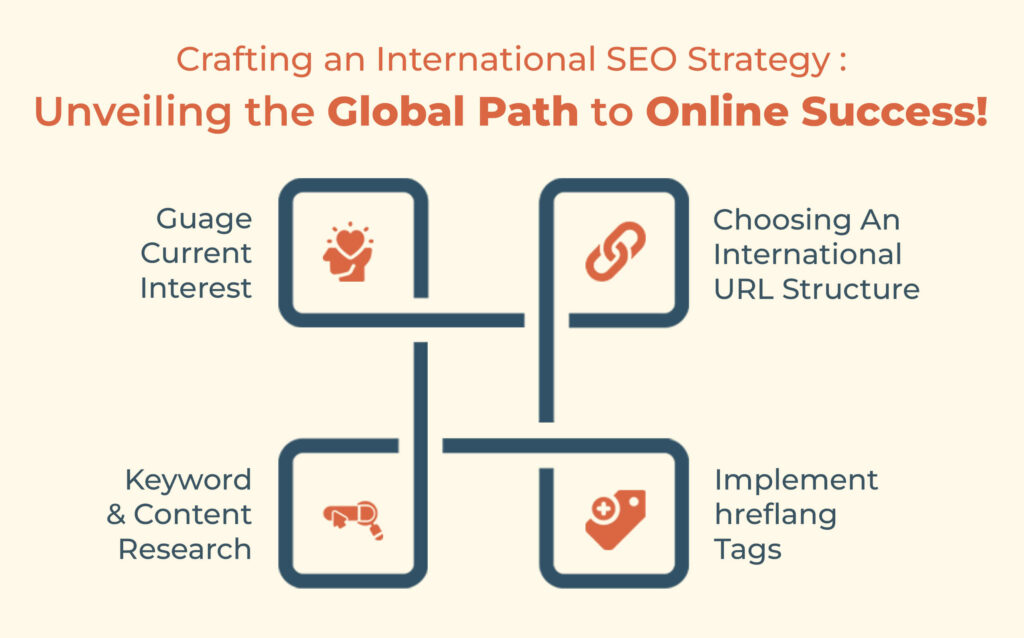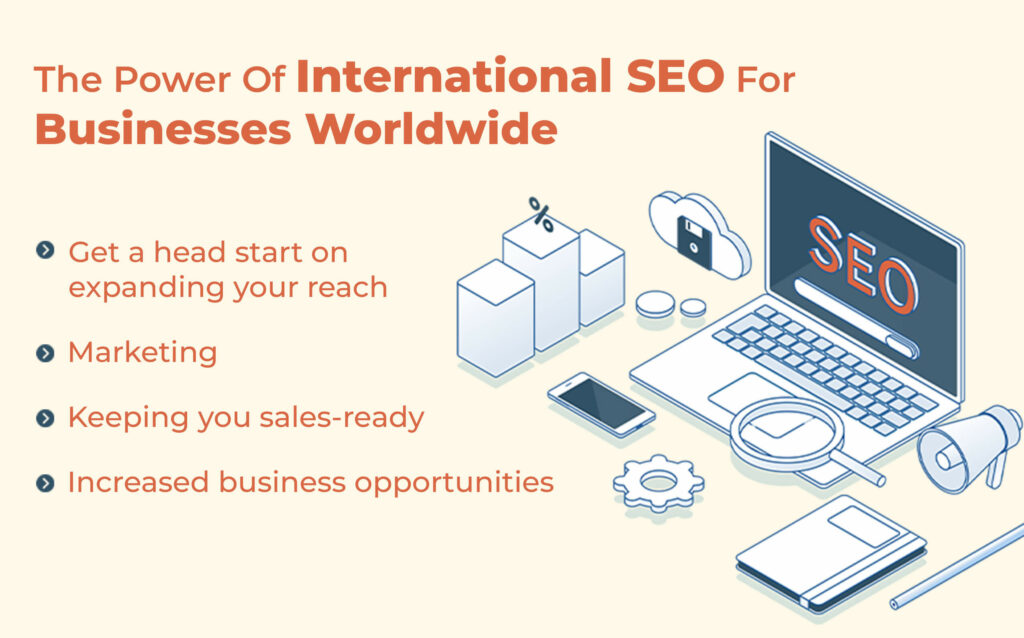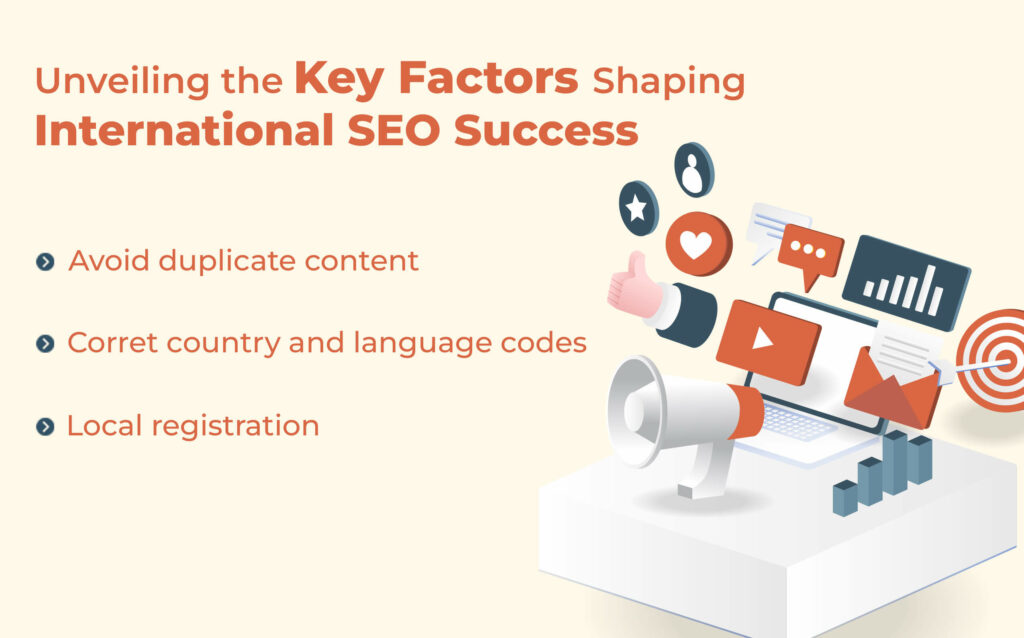“I think I’ve seen you or read about you somewhere!” – Wouldn’t you like it if a guest said this when you introduced yourself at a party? International SEO is the same. It helps you introduce your brand, service, or products to a specific country or particular language-speaking audience.
What is international SEO?

International SEO is the process by which website managers can tap into a new audience from another country or a different language. International SEO is part of a website’s expansion strategy, identifying target countries that may receive your planned website content. By changing a few aspects of your website, you can make search engines reach similar language-speaking countries or countries that may help you improve your business. This practice involves strategic efforts to ensure your website ranks higher in popular search engines for relevant keywords in the target users’ language or country.
How does international SEO work?
International SEO requires work from different perspectives to align your services and product content with the target country’s culture, language, and local preferences. International SEO also works by changing the website structure, along with the content and other web assets. Each country has its standard for transactional currency, time zones, and units of measurement.
The technical changes include subdirectories, subdomains, changes in page title, meta title, and meta description, among others. You can get a better response from the target country search engines if you can get favorable backlinks from reputed local websites. Once your website is internationally SEO-optimized, your target audience will likely see your pages in search results.
Why is international SEO important?
Among the top companies, many drive their sales from international markets. For example, 60% of Apple’s sales come from global markets. International SEO makes the people of your desired audience familiar with your company and its offerings. It paves a pathway to new markets so you can execute marketing campaigns to further capture leads and prospects and grow your business. If your business ambition is to expand beyond borders or eventually start off globally, it’s crucial to prioritize international SEO. People tend to buy from known brands, and SEO is a great way to show your company higher up in search results.
Even if you don’t have plans to grow your business in, say, French-speaking countries, providing value to native speakers helps to show your support for this critical global section, which may be helpful in the future. With International SEO, you can take the lead in tapping into a country that your competitor hasn’t forayed yet. With the appropriate International SEO strategy, you can plan to boost your brand image as a global player.
Do you need to go international?
More than 7000 languages are spoken worldwide. But no company would need to implement SEO for all or most of them. Knowing what will work for your business gives a good start to your strategy. Whether or not International SEO is right for your business will require an introspection of your vision and business growth strategy. A few questions to consider are:
- Can your existing business benefit an audience from another country or the same-language-speaking audience?
- What unique value proposition can you offer to stand out in these international markets?
- What are the potential risks and gains associated with expanding your online presence internationally?
- Can you leverage international SEO to tap into new markets and reach a broader audience as a leading player in these countries?
Prepping up for launching your brand overseas takes as much effort, or more, as would for a full-fledged local online business. Evaluate the possibilities and opportunities that await you when you plan to optimize for a set of international languages or countries.
How to Develop an International SEO Strategy

Gauge current interest
Start by listing the languages or countries in which you want to grow your presence. Is it possible to repurpose the existing content for your current offerings? This will determine the effort required or strategy to plan the next phase of the SEO.
How to start: A good place to peek at your current audience is by analyzing your geographic visits data. It shows the countries your visitors are coming from and can give a fair idea if you can strategize to tap into these countries. Tools like Google Search Console can easily provide you with this data.
Keyword and content research
With a language change, there are a host of changes that must encompass your SEO strategy. Begin by conducting comprehensive keyword research for your target audience’s corresponding topics of interest. Sometimes, you may even find you are already ranking for a few low-volume keywords. Automated translations from your current to the target language may result in irrelevant or incorrect content or keywords.
How to start: Getting help from a native speaker or professional translator is a better approach to creating a new content strategy. Paid and AI translation tools are also alternatives to finding the right keywords for your target audience.
Choosing an international URL structure
Once your content and keywords are in place, it’s time to choose how to deliver the content to your target audience. Depending on your resources and business size, you can have multiple URL structures to serve your target country audience.
- ccTLDs
(“country-code top-level domains”) This global-level URL structure clearly defines the language your website serves and enhances local SEO, making it clear to your target audience and search engines the language content to expect. An example of ccTLDs for American audiences is www.example.us. ccTLDs are a comprehensive way to serve your country-specific audience but are resource-heavy to manage.
- gTLDs (“generic top-level domains”) with subdomains
If you don’t wish to spend too many resources on implementing ccTLDs, you can opt for generic TLDs with subdomains. The two-letter language appears at the start of the domain, like us.example.com.
- gTLDs with subdirectories
Another popular way to distinguish your language-specific pages is gTLDs (“generic top-level domains”) with subdirectories. You can use a subfolder for every language with the parent host site. They’re easier to understand for end users and inform about the language served.
How to start: You can choose one, or a combination of the above methods to serve your international language. While choosing your URL structure for internationalization, consider your SEO cost and effort estimate from one-time to regular maintenance. Expect some ranking volatility when making changes to your URL structures, but by following documented processes.
Implement hreflang Tags
By implementing hreflang tags, a technical addition to your website’s backend, Google and other search engines can map your website’s language-specific pages. It clears the search engines to use the appropriate page to serve as per the search query’s parameters. Check and resolve website errors using free or paid tools for a better user experience on search engines.
International SEO best practices

Some of the best practices for International SEO are:
- Market research on the target country: It’s vital to know as much as possible about your target country as it will help to suit the SEO and content strategy based on the findings. Find out what your competitors are doing to capture the market and build ways to get past your desired audience. Extensive research is needed to find popular and relevant keywords that will fetch interested leads and visitors.
- Content design: By understanding the cultural preferences of your target audience, you can craft meaningful content that entices them to spend more time on your website. Paying attention to local references for your products and services can help to better connect. The content on your website must consider your audience’s age range, socioeconomics, and preferred medium channels of consumption to design engaging content better.
- URL structure: If using a new domain, sub-domain, or sub-domain with a directory, extensive testing is needed to ensure your visitors land on the correct landing page. Create a separate landing page for each language to track and nurture leads and visitors accurately. Since every search engine interprets URLs differently, you can monitor webmaster tools and crawling history to check for crawls. 301 redirects can be used for the required pages to prevent losing potential traffic. It signals to search engines that a URL has permanently moved.
- Aim for local backlinks: Still high in the consideration for trusted sites, backlinks positively impact a new website or any existing site. Create content that’s valuable for someone to share or link to. More high-quality backlinks to your site increase link juice or value passed by another website to yours. Google counts link juice by a webpage as positive votes toward your site.
The Benefits of International SEO for Global Businesses

- Get a head start on expanding your reach.
Globalization is demanding more from companies that offer great quality products and services. With International SEO, businesses have a cost-effective way to reach and serve a similar-language audience or a set of countries.
- Marketing
Whenever you’re ready to scale, you’d want to have a brand known globally. When you optimize your website in different languages and countries, you’re putting your business on a high-visibility platform.
- Keeping you sales-ready
International SEO allows you to reach, connect, and stay engaged with global audiences even if you’re not ready to sell there yet. When the time arrives for you to start your sales activities in these markets, you’re already halfway through to your prospective buyers.
- Increased business opportunities
Starting your marketing activities in a new region can provide business cues for possible partnerships or strategic business ventures. Get ahead of your competitors in testing the depth of market potential with pre-sales or brand engagement activities.
Factors That Affect International SEO

Implementing International SEO is not as difficult as learning a foreign language. Still, you’d need to pay attention to a few points to ensure you’re not causing hurt or harm with incorrect or less impactful language. Here are a few things that can affect your global SEO efforts:
- Avoid duplicate content: Search engines can flag duplicate content without explicitly mentioning hreflang attributes. Use an HTTP header in case your website has non-HTML content.
- Correct country and language codes: Pay attention when using country and language codes. In hreflang values, use ISO 639-1 format while using the ISO 3166-1 Alpha 2 format for country codes.
- Local registration: Search engines may display only verified local businesses in their search results, so it’s best to use local social media accounts like Facebook, LinkedIn, and X, among others to list local businesses.
Takeaway
When implementing International SEO, several benefits await businesses looking to scale operations and reach across countries. Based on your business goals and resources, you can implement SEO in phases through testing for correct landing pages for your targeted country visitors. Like local or same-country SEO efforts, this also requires constant monitoring and watching out for new global or local trends. Once you have mastered engaging with the newly driven traffic from the desired countries or language-specific audiences, you’re assured of global success!








